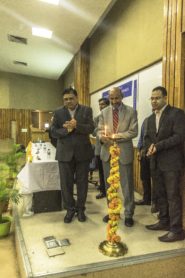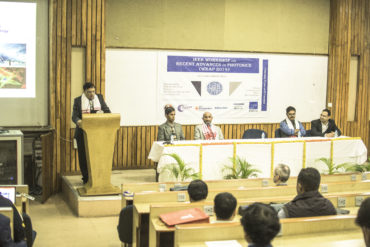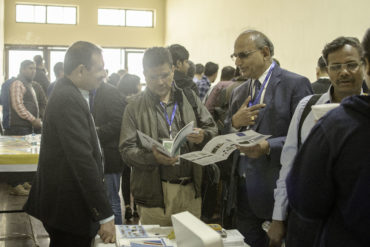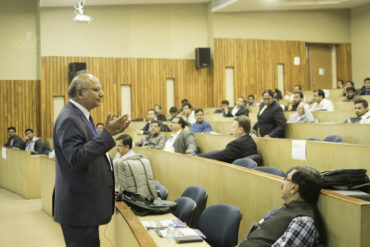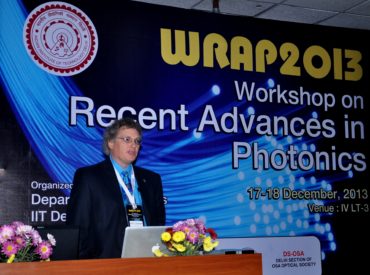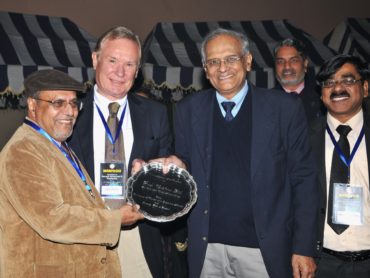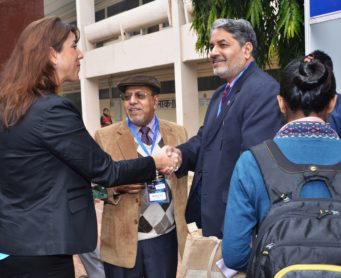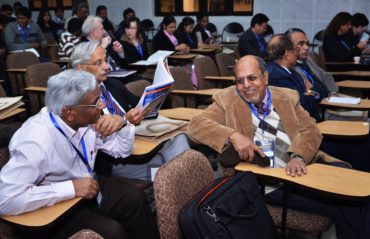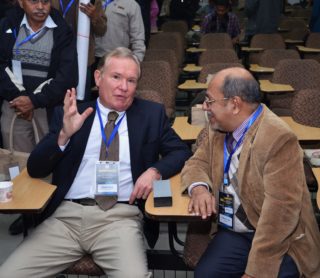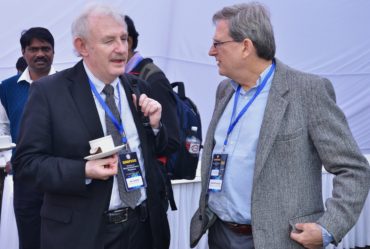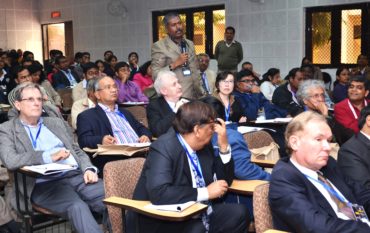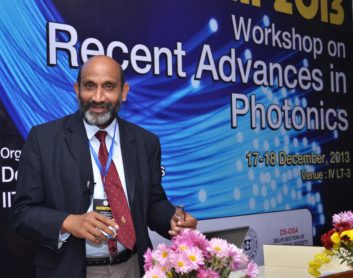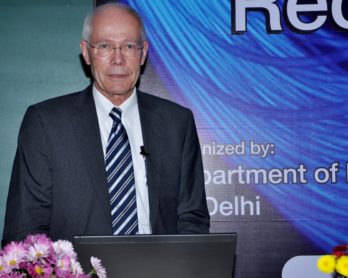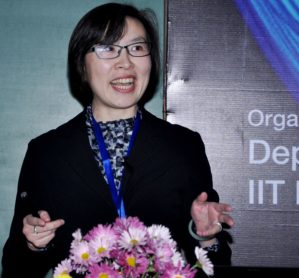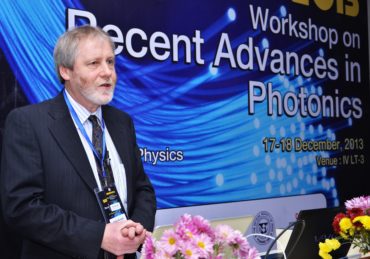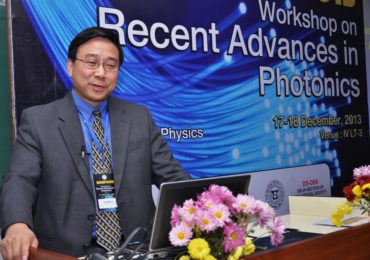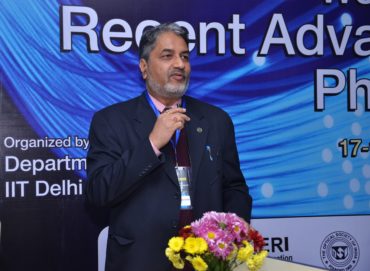WRAP 2013, IIT Delhi, India
The white paper “Lighting the path to a competitive, secure future” brought out by National Photonics Initiative (USA) in May 2013 states that photonics improves quality of life; improves our health, safety, and security, and drives economic growth, job creation, and global competitiveness. In recent years, to promote and inculcate a spirit of innovation in India, numerous initiatives have been introduced by the Indian government to encourage and harness breakthrough technology ideas in the society. One of the significant steps in this direction has been the “India Innovation Initiative” or “i3” – a joint initiative of the Department of Science & Technology (DST) of the Government of India, Confederation of Indian Industry (CII), and the global company Agilent, which aims at promoting young innovators and facilitating the commercialization of their innovations and creating an innovation eco-system in the country by sensitizing, encouraging innovations / the innovators. The Workshop on Recent Advances in Photonics 2013 (WRAP2013) was conceived to catalyze above efforts by providing an interactive platform for inculcating the spirit of innovation amongst young researchers in Photonics by exposing them to invited talks presented by leading global and local experts on state-of-the art in photonics, who were expected to cover the most recent advances and emerging challenges on Photonics in order to motivate research and photonics-based innovation. Christening of the workshop as Workshop on Recent Advances in Photonics with the abbreviation WRAP was coined by Parama Pal from Robert Bosch Center for Cyber Physical Systems at IISc Bangalore.
WRAP2013 was inaugurated by R. K. Shevgaonkar, Director of Indian Institute of Technology Delhi and a Fellow of IEEE on December 17th. 27 invited talks were given by well known experts from around the world in addition to 101 poster papers, accepted after peer review, which were presented by young researchers on two days of the workshop, organized at IIT Delhi campus on December 17th and 18th. David Payne from Optoelectronics Research Center (ORC) University of Southampton delivered the keynote address entitled High power fiber lasers: The new fiber revolution during the inaugural session. Philip Russel from Max Planck Institute for Science of Light, Erlangen, Germany dwelt on Intense light matter interactions in microstructured glass fibers, Govind Agrawal from Institute of Optics, University of Rochester spoke on Dynamic microring resonators while Benjamin Eggleton from University of Sydney, Australia presented his talk on Inducing and harnessing stimulated Brillouin scattering in photonic integrated circuits. There were three key talks on Biophotonics, which was one of the focus areas for this workshop. Kishan Dholakia from University of St Andrews Scotland described emergence of A new spin on optical manipulation for exploitation in Biophotonics, Xinde Li from John Hopkins University Baltimore covered a variety of contemporary topics related to Fiber optics-based micro-imaging technologies for assessing biological tissue histology in vivo, while Sukhdev Roy from Dayalbagh Educational Institute Agra India focused on Trends in ultra-fast all-optical computing with organic molecules and silicon microring resonators. Semiconductor optoelectronics was another focus area, in which Chenupati Jagadish from Australian National University of Canberra highlighted the Technologies involved in silicon nanowires for optoelectronic applications, Kent Choquette from University of Illinois, Urbana Champaign gave details of recent advancements made in VCSELs for the information age, Alan Mickelson from University of Colorado highlighted How to combat process variation in silicon photonics, and Atul Srivastava from NEL-America dwelt on Emergence of photonic integration in the context of next generation high-speed optical communication. Certain issues related to nonlinear photonics were described by Wolfgang Freude from University of Karlsruhe, Germany, Optical waveguide technologies for nonlinear optics and lasers were addressed by Ajoy Kar from Heriot Watt University, Edinburgh, slow light based nano-photonics was discussed by R. K. Sinha from Delhi Technological University, India, and Materials and technology for fiber lasers were discussed by Ranjan Sen from Central Glass and Ceramic Research Institute Kolkata India. Siddharth Ramachandran from University of Boston talked about the emerging topic of Propagation of twisted light inside optical fibers, and Azizur Rahman from City University London discussed Utility of finite element technique to design and analyze terahertz waveguides. Fiber optic sensor area was also covered in the workshop; Ken Grattan from City U London gave a talk on New challenges in structural health monitoring with optical fiber technology and his colleague Tong Sun from same department described several Chemical and bio-sensors for industrial applications. K. Thyagarajan from IIT Delhi introduced the topic of Optical guided wave quantum information. A couple of talks were delivered from photonic industries in India namely Tejas Networks, Bangalore India by Parthasarathi Palais on Reconfigurable optical add-drop multiplexers and Nagaraju Bejwada Revisiting cutoff in bend insensitive fibers for FTTx: Theoretical and practical Considerations from mega fiber manufacturer Sterlite Technologies, Aurangabad, India. A talk each on several other topics like large mode area fiber beyond 50 micrometer was given by Sonali Dasgupta from a consulting company Light CUE, Bangalore, High-index contrast Bragg fibers for nonlinear spectral broadening by Partha Raychaudhuri of IIT Kharagpur India, Low index contrast silicon slot waveguide modeling by Vishnu Priye from Indian School of Mines Dhanbad, Plasmonic waveguiding in photonic bandgap devices by Shyamal K Bhadra from CGCRI Kolkata, and Solar energy harvesting through optical fibers by Naveen Kumar of Institute of Information Technology, Kanchivaram, India.
The workshop was technically sponsored by IEEE Photonics Society (IPS), who hosted a banquet dinner on Day 1 of the workshop and also provided travel subsidy to 10 invited speakers from abroad. This workshop will now be sustained as a biennial event of IPS in India. The next edition of WRAP will be organized by Robert Bosch Center for Cyber Physical Systems at the Indian Institute of Science Bangalore in December 2015. Other technical co-sponsors were UK-India Education and Research Initiative (UKIERI), Optical Society of India (OSI), and Delhi Chapter of OSA The Optical Society. OSI also sponsored 8 best poster paper awards in the form of cash prize of Rs. 5000 each, whose selection was made by a jury of experts. These awards went to All-Optical Ultrafast Reconfigurable Logic Unit with Silicon Microring Resonators by Purnima Sethi and Sukhdev Roy, Department of Physics and Computer Science, Dayalbagh Educational Institute, Agra, India; Spatial Intensity Distribution of Optical Vortex Beams by Salla Gangi Reddy, Shashi Prabhakar, Ashok Kumar, and R. P. Singh, Physical Research Laboratory, Navarangpura, Ahmedabad, India-380 009 and Instituto de Fisica, Universidade de Sao Paulo, Sao Paulo, 66318, Brazil; Effect of Dispersion on Supercontinuum Generation of Suspended Core Photonic Crystal Fiber by Surajit Bose, Rik Chattopadhyay, M. Pal, and S. K. Bhadra, Fiber Optics and Photonics Division CSIR-Central Glass and Ceramic Research Institute, Kolkata, India; Exploiting Microstructured Optical Fiber Platform for Generating Temporal Parabolic Pulse by Ajanta Barh, S. Ghosh, R. K. Varshney, and B. P. Pal, Department of Physics, Indian Institute of Technology Delhi, New Delhi, India, and Institute of Radio Physics, Calcutta University, Kolkata, India; Generation and Detection of THz Radiation from Low Temperature GaAs Photoconductive Antennas using Autocorrelation Technique by M. Venkatesh, A. K. Chaudhary, and K. S. Rao, Advanced Centre of Research in High Energy Materials, University of Hyderabad, India; Nanomaterial-Coated Etched Fiber Bragg Grating Sensors by B. N. Shivananju, Parama Pal, S.Yamdagni, M. M. Varma, and S. Asokan, Department of Instrumentation and Applied Physics, Robert Bosch Centre for Cyber Physical Systems, Instrumentation Scientific Technologies, Center for Nano Science and Engineering, Department of Electrical Communication Engineering, Applied Photonics Initiative, Indian Institute of Science, Bangalore, India; High Resolution Corneal Topography and Tomography of Fish Eye using Full-Field White Light Interference Microscopy with Color Fringe Analysis by Vishal Srivastava, M. Inam, Brijesh Kumar Singh, and D. S. Mehta, Laser Applications and Holography Laboratory, Instrument Design Development Centre, and Department of Physic, Indian Institute of Technology Delhi, New Delhi, India; and Propagation Lengths of Surface Plasmons Guided Along Au and Ag Nanowires by Jitender, Manoj Kumar, Arun Kumar, and R. K. Varshney, Department of Physics, Indian Institute of Technology Delhi, India.
Overall it was a highly successful workshop held for the first time in India at the initiative of IEEE Photonics Society. Total participation was over 240. Technical quality of all talks and poster papers were high. There were no parallel sessions, and all talks had almost 100% attendance including by the invited speakers. The workshop was coordinated by Anurag Sharma and R. K. Varshney of IIT Delhi. The first edition of WRAP was significantly supported by IEEE Photonics Society enabling a galaxy of outstanding researchers in Photonics from around the world to personally honor and coincide with the retirement of Bishnu Pal from IIT Delhi after 34 years of service. A majority of invited speakers from India were former graduate students of Bishnu Pal.
WRAP 2019, IIT Guwahati, India
The 4th edition of biennial IEEE Workshop of Recent Advances in Photonics (WRAP) 2019 was held at the Indian Institute of Technology Guwahati (IITG) during December 13 – 14, 2019. IEEE WRAP 2019 provided a platform to the global experts and researchers to disseminate and highlight novel contributions and challenges and, as an outcome, motivate innovation in the field of Photonics. IITG is one of the prestigious institutes of higher learning spread over 700 acres and is located on the northern banks of mighty Brahmaputra river in North East state Assam of India.
The workshop received an overwhelming response from the scientific community working in optics and photonics. Several eminent professors, scientists, postdocs and students from all around the globe participated in this event. More than 30 eminent speakers from various parts of the world including the USA, Australia, United Kingdom, Canada, South Korea, Austria, etc. delivered lectures over the two days of the event, and around 180 researchers and scientists attended it.
Gallery
